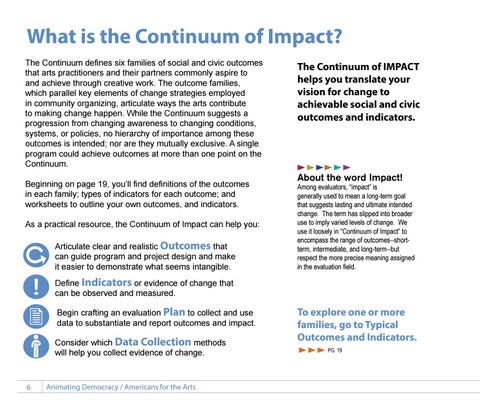What is the Continuum of Impact? The Continuum defines six families of social and civic outcomes that arts practitioners and their partners commonly aspire to and achieve through creative work. The outcome families, which parallel key elements of change strategies employed in community organizing, articulate ways the arts contribute to making change happen. While the Continuum suggests a progression from changing awareness to changing conditions, systems, or policies, no hierarchy of importance among these outcomes is intended; nor are they mutually exclusive. A single program could achieve outcomes at more than one point on the Continuum. Beginning on page 19, you’ll find definitions of the outcomes in each family; types of indicators for each outcome; and worksheets to outline your own outcomes, and indicators. As a practical resource, the Continuum of Impact can help you: Articulate clear and realistic Outcomes that can guide program and project design and make it easier to demonstrate what seems intangible.
The Continuum of IMPACT helps you translate your vision for change to achievable social and civic outcomes and indicators.
About the word Impact!
Among evaluators, “impact” is generally used to mean a long-term goal that suggests lasting and ultimate intended change. The term has slipped into broader use to imply varied levels of change. We use it loosely in “Continuum of Impact” to encompass the range of outcomes--shortterm, intermediate, and long-term--but respect the more precise meaning assigned in the evaluation field.
Define Indicators or evidence of change that can be observed and measured. Begin crafting an evaluation Plan to collect and use data to substantiate and report outcomes and impact. Consider which Data Collection methods will help you collect evidence of change.
6
Animating Democracy / Americans for the Arts
To explore one or more families, go to Typical Outcomes and Indicators. PG. 19
